Lenovo M900X, M900, M700 User Manual
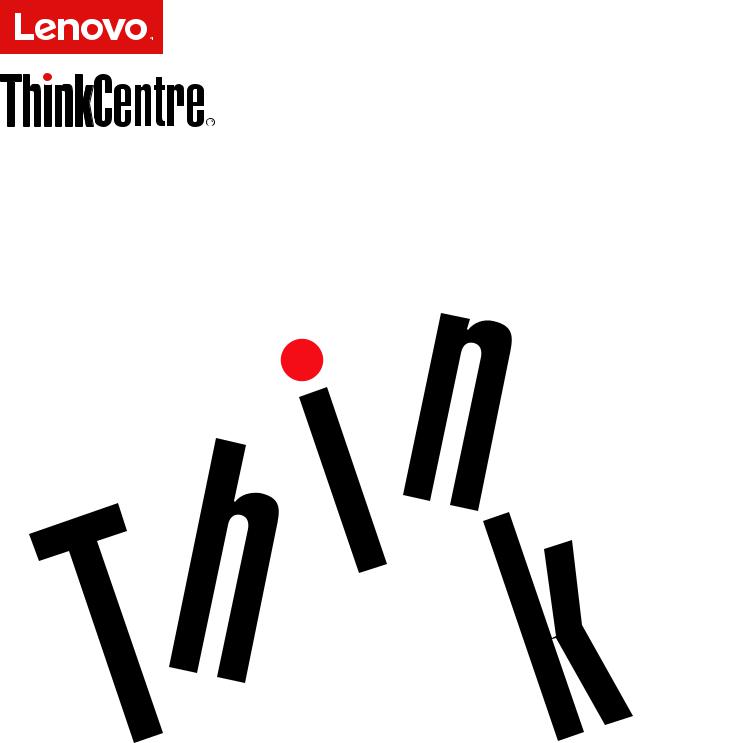
ThinkCentre M700, M900 and M900x
Hardware Maintenance Manual
Machine Types: 10FL, 10FM, 10FR, 10FS, 10HY, 10J0, 10JM, 10JN, 10JQ, 10JR, 10JS, 10JT, 10LX, 10LY, 10M6, 10ND, 10NE, 10NF, and 10NG
Note: Before using this information and the product it supports, be sure to read and understand the Chapter 1 “Read this first: Important safety information” on page 1 and Appendix F “Notices” on page 157.
Third Edition (July 2016)
© Copyright Lenovo 2015, 2016.
LIMITED AND RESTRICTED RIGHTS NOTICE: If data or software is delivered pursuant to a General Services Administration “GSA” contract, use, reproduction, or disclosure is subject to restrictions set forth in Contract No. GS-35F-05925.

Contents
About this manual. . . . . . . . . . . . |
v |
Chapter 1. Read this first: Important |
|
safety information. . . . . . . . . . . . |
1 |
Power cords and power adapters . . . . . . . . |
1 |
General safety . . . . . . . . . . . . . . . . |
1 |
Electrical safety . . . . . . . . . . . . . . . |
2 |
Safety inspection guide . . . . . . . . . . . . |
4 |
Handling electrostatic discharge-sensitive |
|
devices . . . . . . . . . . . . . . . . . . |
4 |
Grounding requirements . . . . . . . . . . . . |
5 |
Safety notices (multi-lingual translations) . . . . . |
5 |
Chapter 2. Product overview . . . . . |
27 |
Hardware locations . . . . . . . . . . . . . |
27 |
Front view. . . . . . . . . . . . . . . |
27 |
Rear view . . . . . . . . . . . . . . . |
29 |
Computer components . . . . . . . . . |
31 |
Major FRUs and CRUs. . . . . . . . . . |
32 |
Parts on the system board . . . . . . . . |
34 |
Machine type and model label. . . . . . . |
35 |
Features . . . . . . . . . . . . . . . . . |
35 |
Specifications . . . . . . . . . . . . . . . |
38 |
Programs . . . . . . . . . . . . . . . . . |
38 |
Accessing a program on the computer . . . |
38 |
Installing a program that is ready to be |
|
installed . . . . . . . . . . . . . . . |
39 |
An introduction to Lenovo programs . . . . |
39 |
Chapter 3. Using your computer . . . |
41 |
Registering the computer . . . . . . . . . . |
41 |
Setting the computer volume . . . . . . . . . |
41 |
Adding an icon to the Windows notification area . |
41 |
Using a disc. . . . . . . . . . . . . . . . |
41 |
Guidelines about using the optical drive . . . |
42 |
Handling and storing a disc . . . . . . . . |
42 |
Playing and removing a disc . . . . . . . |
42 |
Recording a disc . . . . . . . . . . . . |
43 |
Connecting to a network . . . . . . . . . . . |
43 |
Connecting to an Ethernet LAN . . . . . . |
43 |
Connecting to a wireless LAN . . . . . . . |
44 |
Connecting to a Bluetooth-enabled device . . |
44 |
I/O box. . . . . . . . . . . . . . . . . . |
44 |
About the I/O box. . . . . . . . . . . . |
44 |
Using the I/O box . . . . . . . . . . . . |
45 |
External battery box . . . . . . . . . . . . |
45 |
Battery safety information . . . . . . . . |
45 |
Using the external battery kit . . . . . . . |
46 |
Chapter 4. You and your computer . |
. |
49 |
Arranging your workspace . . . . . . . . . |
. |
49 |
Glare and lighting . . . . . . . . . . . |
. |
49 |
Air circulation . . . . . . . . . . . . |
. |
49 |
Electrical outlet locations and cable lengths |
. |
49 |
Comfort . . . . . . . . . . . . . . |
. |
49 |
Accessibility information . . . . . . . . . . |
. |
50 |
Cleaning the computer . . . . . . . . . . |
. |
53 |
Maintenance . . . . . . . . . . . . . . |
. |
53 |
Basic maintenance tips . . . . . . . . |
. |
53 |
Good maintenance practices . . . . . . |
. |
53 |
Keeping the computer current . . . . . . |
. |
54 |
Moving the computer . . . . . . . . . . . |
. |
55 |
Chapter 5. Security . . . . . . . . . . |
57 |
Locking the computer . . . . . . . . . . . . |
57 |
Locking the computer cover . . . . . . . |
57 |
Attaching a Kensington-style cable lock . . . |
59 |
Viewing and changing security settings in the |
|
Setup Utility program . . . . . . . . . . . . |
59 |
Preventing unauthorized access to the computer . |
59 |
Using fingerprint authentication . . . . . . . . |
60 |
Using and understanding firewalls . . . . . . . |
60 |
Protecting data against viruses . . . . . . . . |
60 |
Computrace Agent software embedded in |
|
firmware . . . . . . . . . . . . . . . . . |
61 |
Trusted Platform Module (TPM) . . . . . . . . |
61 |
Chapter 6. Advanced configuration . . |
63 |
Using the Setup Utility program . . . . . . . . |
63 |
Starting the Setup Utility program . . . . . |
63 |
Enabling or disabling a device . . . . . . . |
63 |
Enabling or disabling the Automatic Power On |
|
features . . . . . . . . . . . . . . . |
63 |
Enabling or disabling the ErP LPS compliance |
|
mode . . . . . . . . . . . . . . . . |
64 |
Changing the ICE performance mode . . . . |
64 |
Enabling or disabling the ICE Thermal Alert |
|
feature . . . . . . . . . . . . . . . . |
64 |
Enabling or disabling the Configuration |
|
Change Detection feature . . . . . . . . |
65 |
Using the cover presence switch. . . . . . |
65 |
Using BIOS passwords . . . . . . . . . |
65 |
Selecting a startup device . . . . . . . . |
67 |
Exiting the Setup Utility program . . . . . . |
67 |
Updating and recovering the BIOS . . . . . . . |
68 |
© Copyright Lenovo 2015, 2016 |
i |
Updating the BIOS . . . . . . . . . . . 68
Chapter 7. Troubleshooting, |
|
diagnostics, and recovery . . . . . . |
69 |
Basic procedure for resolving computer |
|
problems . . . . . . . . . . . . . . . . . |
69 |
Troubleshooting . . . . . . . . . . . . . . |
69 |
Startup problems . . . . . . . . . . . . |
69 |
Audio problems . . . . . . . . . . . . |
70 |
CD problems . . . . . . . . . . . . . |
71 |
DVD problems . . . . . . . . . . . . . |
71 |
Intermittent problems . . . . . . . . . . |
72 |
Storage drive problems . . . . . . . . . |
72 |
Networking problems . . . . . . . . . . |
73 |
Performance problems. . . . . . . . . . |
75 |
Serial connector cannot be accessed . . . . |
76 |
USB device problems . . . . . . . . . . |
76 |
Software and driver problems . . . . . . . |
76 |
Diagnostics . . . . . . . . . . . . . . . . |
77 |
Lenovo Solution Center . . . . . . . . . |
77 |
UEFI diagnostic program . . . . . . . . . |
77 |
Recovery information . . . . . . . . . . . . |
78 |
Recovery information for Windows 7 . . . . |
78 |
Recovery information for Windows 10. . . . |
79 |
Chapter 8. Service checkout and |
|
symptom-to-FRU index . . . . . . . . |
81 |
Service checkout. . . . . . . . . . . . . . |
81 |
Problem determination tips . . . . . . . . |
81 |
Symptom-to-FRU index . . . . . . . . . . . |
82 |
Hard disk drive boot error . . . . . . . . |
82 |
Power supply problems . . . . . . . . . |
83 |
Beep symptoms . . . . . . . . . . . . |
83 |
POST error codes. . . . . . . . . . . . |
83 |
Miscellaneous error conditions . . . . . . |
84 |
Undetermined problems . . . . . . . . . |
86 |
Chapter 9. Installing or replacing |
|
hardware . . . . . . . . . . . . . . . |
87 |
Handling static-sensitive devices . . . . . . . |
87 |
Installing or replacing hardware . . . . . . . . |
87 |
Installing external options . . . . . . . . |
87 |
Replacing the power adapter . . . . . . . |
88 |
Replacing the vertical stand. . . . . . . . |
89 |
Replacing the VESA mount bracket. . . . . |
91 |
Replacing the external optical drive. . . . . |
93 |
Replacing the I/O box . . . . . . . . . . |
99 |
Replacing the external battery box . . . . . |
102 |
Replacing the power adapter bracket . . . . 106 |
|
Removing the computer cover. . . . . . . |
109 |
Replacing the system fan. . . . . . . . . |
111 |
Replacing the internal speaker. . . . . . . |
114 |
Replacing the internal speaker holder . . . . 116 |
|
Replacing the heat sink . . . . . . . . . |
117 |
Replacing the microprocessor . . . . . . . |
119 |
Replacing the storage drive . . . . . . . . |
122 |
Replacing a memory module . . . . . . . |
126 |
Replacing the coin-cell battery . . . . . . |
127 |
Replacing the Wi-Fi card . . . . . . . . . |
128 |
Replacing the Wi-Fi antennas . . . . . . . |
130 |
Replacing the system board . . . . . . . |
133 |
Completing the parts replacement . . . . . |
135 |
Chapter 10. Getting information, help, |
|
and service . . . . . . . . . . . . . |
139 |
Information resources . . . . . . . . . . . . |
139 |
Accessing the user guide in various |
|
languages. . . . . . . . . . . . . . . |
139 |
Windows help system . . . . . . . . . . |
139 |
Safety and warranty . . . . . . . . . . . |
139 |
Lenovo Web site . . . . . . . . . . . . |
139 |
Lenovo Support Web site. . . . . . . . . |
140 |
Frequently asked questions . . . . . . . . |
140 |
Help and service . . . . . . . . . . . . . . |
140 |
Calling for service. . . . . . . . . . . . |
140 |
Using other services . . . . . . . . . . |
141 |
Purchasing additional services . . . . . . |
141 |
Appendix A. Regulatory |
|
information . . . . . . . . . . . . . |
143 |
Export classification notice . . . . . . . . . . |
143 |
Electronic emissions notices . . . . . . . . . |
143 |
Federal Communications Commission |
|
Declaration of Conformity . . . . . . . . |
143 |
Eurasian compliance mark . . . . . . . . . . |
145 |
Brazil audio notice . . . . . . . . . . . . . |
145 |
Mexico wireless-radio compliance information . . |
145 |
Additional regulatory information . . . . . . . |
146 |
Appendix B. WEEE and recycling |
|
information . . . . . . . . . . . . . |
147 |
Important WEEE information . . . . . . . . . |
147 |
Recycling information for Japan . . . . . . . . |
147 |
Recycling information for Brazil . . . . . . . . |
148 |
Battery recycling information for Taiwan. . . . . |
148 |
Battery recycling information for the European |
|
Union . . . . . . . . . . . . . . . . . . |
149 |
Appendix C. Restriction of Hazardous Substances (RoHS) Directive . . . . 151
European Union RoHS . . . . . . . . . . . |
151 |
China RoHS. . . . . . . . . . . . . . . . |
151 |
Turkish RoHS . . . . . . . . . . . . . . . |
151 |
ii ThinkCentre M700, M900 and M900x Hardware Maintenance Manual

Ukraine RoHS . . . . . . . . . . . . . . . |
152 |
Appendix F. Notices . . . . . . . . . |
157 |
India RoHS . . . . . . . . . . . . . . . . |
152 |
Trademarks . . . . . . . . . . . . . . . . |
158 |
Appendix D. China Energy Label . . 153
Appendix E. ENERGY STAR model information . . . . . . . . . . . . . 155
© Copyright Lenovo 2015, 2016 |
iii |
iv ThinkCentre M700, M900 and M900x Hardware Maintenance Manual

About this manual
This manual provides service and reference information for Lenovo® computers listed on the front cover.
Use this manual along with the advanced diagnostic tests to troubleshoot problems.
Important: This manual is intended only for trained service technicians who are familiar with Lenovo computers. Use this manual along with the advanced diagnostic tests to troubleshoot problems effectively. Before servicing a Lenovo computer, be sure to read and understand Chapter 1 “Read this first: Important safety information” on page 1.
© Copyright Lenovo 2015, 2016 |
v |
vi ThinkCentre M700, M900 and M900x Hardware Maintenance Manual

Chapter 1. Read this first: Important safety information
CAUTION:
Before using the computer, be sure to read and understand all the related safety information for this product. Refer to the safety information in this section and in the Safety and Warranty Guide that you received with this product. Reading and understanding all the safety information reduces the risk of personal injury and damage to your product. If you no longer have a copy of the Safety and Warranty Guide, you can obtain a Portable Document Format (PDF) version from the Lenovo® Support Web site at http://www.lenovo.com/UserManuals.
Power cords and power adapters
Use only the power cords and power adapters supplied by the product manufacturer. Do not use the ac power cord for other devices.
The power cords shall be safety approved. For Germany, it shall be H03VV-F, 3G, 0.75 mm2 (the power cord connected to the power adapter), H05VV-F, 3G, 0.75 mm2 (the power cord connected to the internal power supply assembly), or better. For other countries, the suitable types shall be used accordingly.
Never wrap a power cord around a power adapter or other object. Doing so can stress the cord in ways that can cause the cord to fray, crack, or crimp. This can present a safety hazard.
Always route power cords so that they will not be walked on, tripped over, or pinched by objects.
Protect power cord and power adapters from liquids. For instance, do not leave your power cord or power adapter near sinks, tubs, toilets, or on floors that are cleaned with liquid cleansers. Liquids can cause a short circuit, particularly if the power cord or power adapter has been stressed by misuse. Liquids also can cause gradual corrosion of power cord terminals and/or the connector terminals on a power adapter, which can eventually result in overheating.
Ensure that all power cord connectors are securely and completely plugged into receptacles.
Do not use any power adapter that shows corrosion at the ac input pins or shows signs of overheating (such as deformed plastic) at the ac input or anywhere on the power adapter.
Do not use any power cords where the electrical contacts on either end show signs of corrosion or overheating or where the power cord appears to have been damaged in any way.
General safety
Follow these rules to ensure general safety:
•Observe good housekeeping in the area of the machines during and after maintenance.
•When lifting any heavy object:
1.Ensure you can stand safely without slipping.
2.Distribute the weight of the object equally between your feet.
3.Use a slow lifting force. Never move suddenly or twist when you attempt to lift.
4.Lift by standing or by pushing up with your leg muscles; this action removes the strain from the muscles in your back.
© Copyright Lenovo 2015, 2016 |
1 |
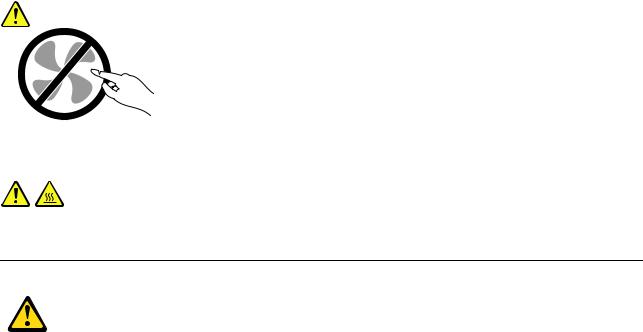
Attention:
Do not attempt to lift any objects that weigh more than 16 kg (35 lb) or objects that you think are too heavy for you.
•Do not perform any action that causes hazards to the customer, or that makes the equipment unsafe.
•Before you start the machine, ensure that other service representatives and the customer's personnel are not in a hazardous position.
•Place removed covers and other parts in a safe place, away from all personnel, while you are servicing the machine.
•Keep your tool case away from walk areas so that other people will not trip over it.
•Do not wear loose clothing that can be trapped in the moving parts of a machine. Ensure that your sleeves are fastened or rolled up above your elbows. If your hair is long, fasten it.
•Insert the ends of your necktie or scarf inside clothing or fasten it with a nonconductive clip, approximately 8 centimeters (3 inches) from the end.
•Do not wear jewelry, chains, metal-frame eyeglasses, or metal fasteners for your clothing. Remember: Metal objects are good electrical conductors.
•Wear safety glasses when you are: hammering, drilling, soldering, cutting wire, attaching springs, using solvents, or working in any other conditions that might be hazardous to your eyes.
•After service, reinstall all safety shields, guards, labels, and ground wires. Replace any safety device that is worn or defective.
•Reinstall all covers correctly before returning the machine to the customer.
CAUTION:
Hazardous moving parts. Keep fingers and other body parts away.
CAUTION:
Before you open the computer cover, turn off the computer and wait several minutes until the computer is cool.
Electrical safety
CAUTION:
Electrical current from power, telephone, and communication cables can be hazardous. To avoid personal injury or equipment damage, disconnect the attached power cords, telecommunication systems, networks, and modems before you open the computer covers, unless instructed otherwise in the installation and configuration procedures.
2 ThinkCentre M700, M900 and M900x Hardware Maintenance Manual
Observe the following rules when working on electrical equipment.
Important: Use only approved tools and test equipment. Some hand tools have handles covered with a soft material that does not insulate you when working with live electrical currents. Many customers have, near their equipment, rubber floor mats that contain small conductive fibers to decrease electrostatic discharges. Do not use this type of mat to protect yourself from electrical shock.
•Find the room emergency power-off (EPO) switch, disconnecting switch, or electrical outlet. If an electrical accident occurs, you can then operate the switch or unplug the power cord quickly.
•Do not work alone under hazardous conditions or near equipment that has hazardous voltages.
•Disconnect all power before:
–Performing a mechanical inspection
–Working near power supplies
–Removing or installing Field Replaceable Units (FRUs)
•Before you start to work on the machine, unplug the power cord. If you cannot unplug it, power off the wall box that supplies power to the machine and lock the wall box in the off position.
•If you need to work on a machine that has exposed electrical circuits, observe the following precautions:
–Ensure that another person, familiar with the power-off controls, is near you. Remember: Another person must be there to switch off the power, if necessary.
–Use only one hand when working with powered-on electrical equipment; keep the other hand in your pocket or behind your back.
Remember: There must be a complete circuit to cause electrical shock. By observing the above rule, you may prevent a current from passing through your body.
–When using a tester, set the controls correctly and use the approved probe leads and accessories for that tester.
–Stand on suitable rubber mats (obtained locally, if necessary) to insulate you from grounds such as metal floor strips and machine frames.
Observe the special safety precautions when you work with very high voltages; these instructions are in the safety sections of maintenance information. Use extreme care when measuring high voltages.
•Regularly inspect and maintain your electrical hand tools for safe operational condition.
•Do not use worn or broken tools and testers.
•Never assume that power has been disconnected from a circuit. First, check that it has been powered-off.
•Always look carefully for possible hazards in your work area. Examples of these hazards are moist floors, nongrounded power extension cables, power surges, and missing safety grounds.
•Do not touch live electrical circuits with the reflective surface of a plastic dental mirror. The surface is conductive; such touching can cause personal injury and machine damage.
•Do not service the following parts with the power on when they are removed from their normal operating places in a machine:
–Power supply units
–Pumps
–Blowers and fans
–Motor generators
and similar units. (This practice ensures correct grounding of the units.)
•If an electrical accident occurs:
–Use caution; do not become a victim yourself.
–Switch off power.
Chapter 1. Read this first: Important safety information 3

– Send another person to get medical aid.
Safety inspection guide
The intent of this inspection guide is to assist you in identifying potentially unsafe conditions on these products. Each machine, as it was designed and built, had required safety items installed to protect users and service personnel from injury. This guide addresses only those items. However, good judgment should be used to identify potential safety hazards due to attachment of features or options not covered by this inspection guide.
If any unsafe conditions are present, you must determine how serious the apparent hazard could be and whether you can continue without first correcting the problem.
Consider these conditions and the safety hazards they present:
•Electrical hazards, especially primary power (primary voltage on the frame can cause serious or fatal electrical shock).
•Explosive hazards, such as a damaged CRT face or bulging capacitor
•Mechanical hazards, such as loose or missing hardware
The guide consists of a series of steps presented in a checklist. Begin the checks with the power off, and the power cord disconnected.
Checklist:
1.Check exterior covers for damage (loose, broken, or sharp edges).
2.Power-off the computer. Disconnect the power cord.
3.Check the power cord for:
a.A third-wire ground connector in good condition. Use a meter to measure third-wire ground continuity for 0.1 ohm or less between the external ground pin and frame ground.
b.The power cord should be the appropriate type as specified in the parts listings.
c.Insulation must not be frayed or worn.
4.Remove the cover.
5.Check for any obvious alterations. Use good judgment as to the safety of any alterations.
6.Check inside the unit for any obvious unsafe conditions, such as metal filings, contamination, water or other liquids, or signs of fire or smoke damage.
7.Check for worn, frayed, or pinched cables.
8.Check that the power-supply cover fasteners (screws or rivets) have not been removed or tampered with.
Handling electrostatic discharge-sensitive devices
Any computer part containing transistors or integrated circuits (ICs) should be considered sensitive to electrostatic discharge (ESD). ESD damage can occur when there is a difference in charge between objects. To protect against ESD damage, equalize the charge between objects. Then, the machine, the part, the work mat, and the person handling the part are all at the same charge.
Notes:
1.Use product-specific ESD procedures when they exceed the requirements noted here.
2.Make sure that the ESD protective devices you use have been certified (ISO 9000) as fully effective.
When handling ESD-sensitive parts:
• Keep the parts in protective packages until they are inserted into the product.
4 ThinkCentre M700, M900 and M900x Hardware Maintenance Manual

•Avoid contact with other people while handling the part.
•Wear a grounded wrist strap against your skin to eliminate static on your body.
•Prevent the part from touching your clothing. Most clothing is insulative and retains a charge even when you are wearing a wrist strap.
•Use the black side of a grounded work mat to provide a static-free work surface. The mat is especially useful when handling ESD-sensitive devices.
•Select a grounding system, such as those listed below, to provide protection that meets the specific service requirement.
Note: The use of a grounding system is desirable but not required to protect against ESD damage.
–Attach the ESD ground clip to any frame ground, ground braid, or green-wire ground.
–Use an ESD common ground or reference point when working on a double-insulated or battery-operated system. You can use coax or connector-outside shells on these systems.
–Use the round ground-prong of the ac plug on ac-operated computers.
Grounding requirements
Electrical grounding of the computer is required for operator safety and correct system function. Proper grounding of the electrical outlet can be verified by a certified electrician.
Safety notices (multi-lingual translations)
The caution and danger safety notices in this section are provided in the following languages:
•English
•Arabic
•Brazilian/Portuguese
•Chinese (simplified)
•Chinese (traditional)
•French
•German
•Hebrew
•Italian
•Korean
•Spanish
DANGER
Electrical current from power, telephone and communication cables is hazardous.
To avoid a shock hazard:
•Do not connect or disconnect any cables or perform installation, maintenance, or reconfiguration of this product during an electrical storm.
Chapter 1. Read this first: Important safety information 5
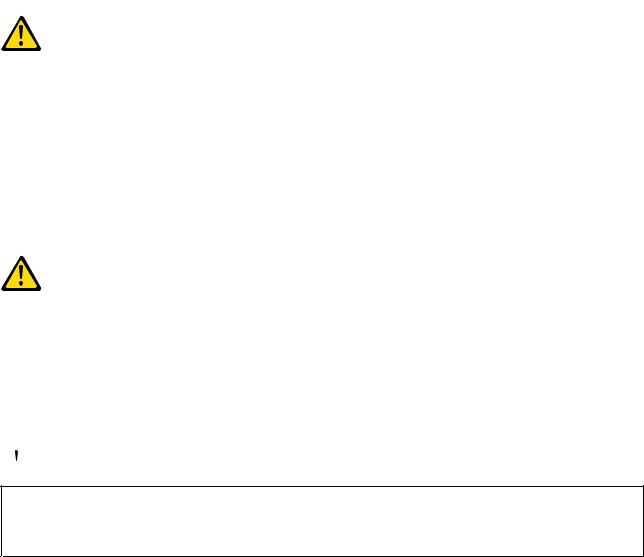
•Connect all power cords to a properly wired and grounded electrical outlet.
•Connect to properly wired outlets any equipment that will be attached to this product.
•When possible, use one hand only to connect or disconnect signal cables.
•Never turn on any equipment when there is evidence of fire, water, or structural damage.
•Disconnect the attached power cords, telecommunications systems, networks, and modems before you open the device covers, unless instructed otherwise in the installation and configuration procedures.
•Connect and disconnect cables as described in the following tables when installing, moving, or opening covers on this product or attached devices.
To Connect |
To Disconnect |
||
|
|
|
|
1. |
Turn everything OFF. |
1. |
Turn everything OFF. |
2. |
First, attach all cables to devices. |
2. |
First, remove power cords from outlet. |
3. |
Attach signal cables to connectors. |
3. |
Remove signal cables from connectors. |
4. |
Attach power cords to outlet. |
4. |
Remove all cables from devices. |
5. |
Turn device ON. |
|
|
|
|
|
|
CAUTION:
When replacing the lithium battery, use only Part Number 45C1566 or an equivalent type battery recommended by the manufacturer. If your system has a module containing a lithium battery, replace it only with the same module type made by the same manufacturer. The battery contains lithium and can explode if not properly used, handled, or disposed of. Do not:
•Throw or immerse into water
•Heat to more than 100°C (212°F)
•Repair or disassemble
Dispose of the battery as required by local ordinances or regulations.
CAUTION:
When laser products (such as CD-ROMs, DVD-ROM drives, fiber optic devices, or transmitters) are installed, note the following:
•Do not remove the covers. Removing the covers of the laser product could result in exposure to hazardous laser radiation. There are no serviceable parts inside the device.
•Use of controls or adjustments or performance of procedures other than those specified herein might result in hazardous radiation exposure.
 DANGER
DANGER
Some laser products contain an embedded Class 3A or Class 3B laser diode. Note the following:
Laser radiation when open. Do not stare into the beam, do not view directly with optical instruments, and avoid direct exposure to the beam.
6 ThinkCentre M700, M900 and M900x Hardware Maintenance Manual
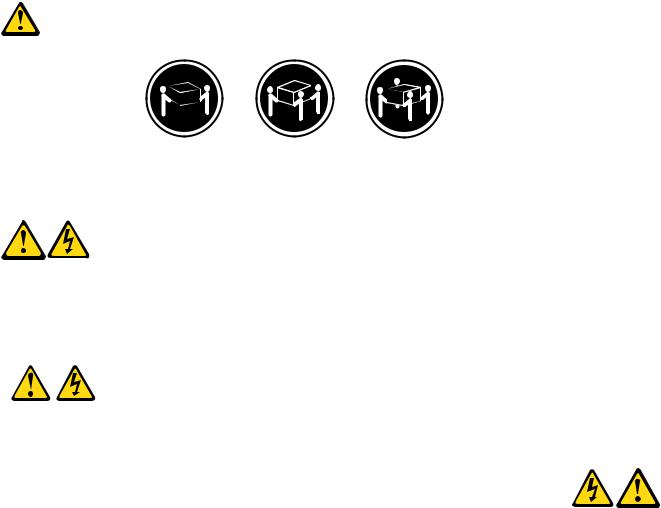
≥18 kg (37 lb) |
≥32 kg (70.5 lb) |
≥55 kg (121.2 lb) |
CAUTION:
Use safe practices when lifting.
CAUTION:
The power control button on the device and the power switch on the power supply do not turn off the electrical current supplied to the device. The device also might have more than one power cord. To remove all electrical current from the device, ensure that all power cords are disconnected from the power source.
2 


 1
1 



Chapter 1. Read this first: Important safety information 7
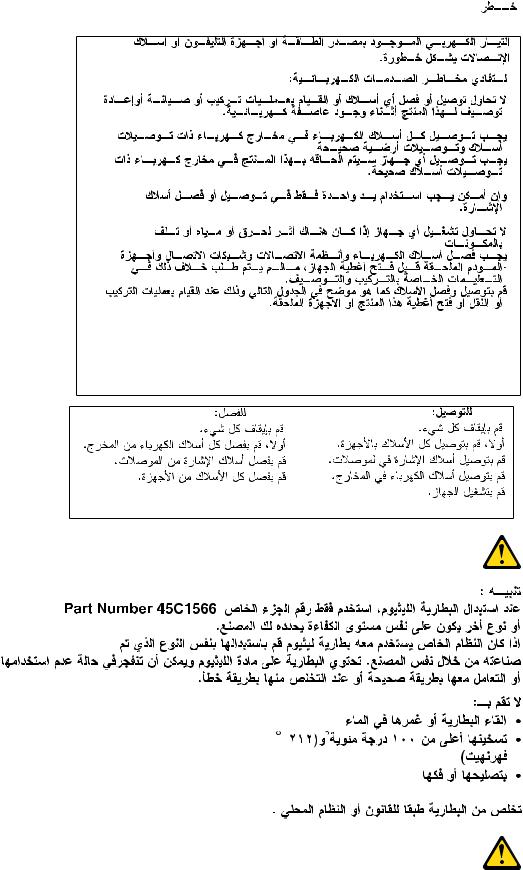
8 ThinkCentre M700, M900 and M900x Hardware Maintenance Manual
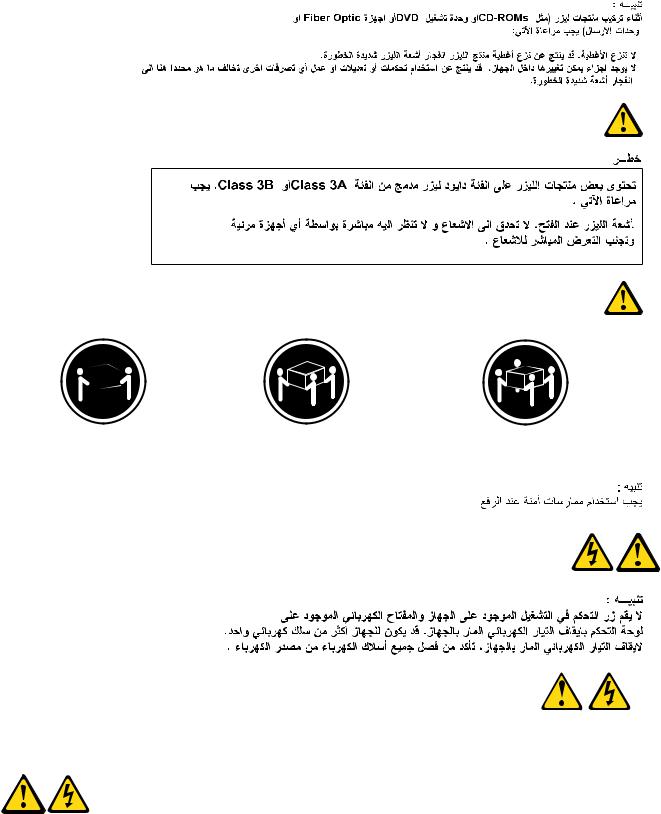
≥18 kg (37 lb) |
≥32 kg (70.5 lb) |
≥55 kg (121.2 lb) |
2 


 1
1 



PERIGO
A corrente elétrica proveniente de cabos de alimentação, de telefone e de comunicações é perigosa.
Chapter 1. Read this first: Important safety information 9

Para evitar risco de choque elétrico:
•Não conecte nem desconecte nenhum cabo ou execute instalação, manutenção ou reconfiguração deste produto durante uma tempestade com raios.
•Conecte todos os cabos de alimentação a tomadas elétricas corretamente instaladas e aterradas.
•Todo equipamento que for conectado a este produto deve ser conectado a tomadas corretamente instaladas.
•Quando possível, utilize apenas uma das mãos para conectar ou desconectar cabos de sinal.
•Nunca ligue nenhum equipamento quando houver evidência de fogo, água ou danos estruturais.
•Antes de abrir tampas de dispositivos, desconecte cabos de alimentação, sistemas de telecomunicação, redes e modems conectados, a menos que especificado de maneira diferente nos procedimentos de instalação e configuração.
•Conecte e desconecte os cabos conforme descrito na tabela apresentada a seguir ao instalar, mover ou abrir tampas deste produto ou de dispositivos conectados.
Para Conectar: |
Para Desconectar: |
||
|
|
|
|
1. |
DESLIGUE Tudo. |
1. |
DESLIGUE Tudo. |
2. |
Primeiramente, conecte todos os cabos aos |
2. |
Primeiramente, remova os cabos de alimentação das |
|
dispositivos. |
|
tomadas. |
3. |
Conecte os cabos de sinal aos conectores. |
3. |
Remova os cabos de sinal dos conectores. |
4. |
Conecte os cabos de alimentação às tomadas. |
4. |
Remova todos os cabos dos dispositivos. |
5. |
LIGUE os dispositivos. |
|
|
|
|
|
|
CUIDADO:
Ao substituir a bateria de lítio, utilize apenas uma bateria com Número de Peça 45C1566 ou um tipo de bateria equivalente recomendado pelo Se o seu sistema possui um módulo com uma bateria de lítio, substitua-o apenas por um módulo do mesmo tipo e do mesmo fabricante. A bateria contém lítio e pode explodir se não for utilizada, manuseada ou descartada de maneira correta.
Não:
•Jogue ou coloque na água
•Aqueça a mais de 100°C (212°F)
•Conserte nem desmonte
Descarte a bateria conforme requerido pelas leis ou regulamentos locais.
PRECAUCIÓN:
Quando produtos a laser (como unidades de CD-ROMs, unidades de DVD-ROM, dispositivos de fibra ótica ou transmissores) estiverem instalados, observe o seguinte:
•Não remova as tampas. A remoção das tampas de um produto a laser pode resultar em exposição prejudicial à radiação de laser. Não existem peças que podem ser consertadas no interior do dispositivo.
10 ThinkCentre M700, M900 and M900x Hardware Maintenance Manual
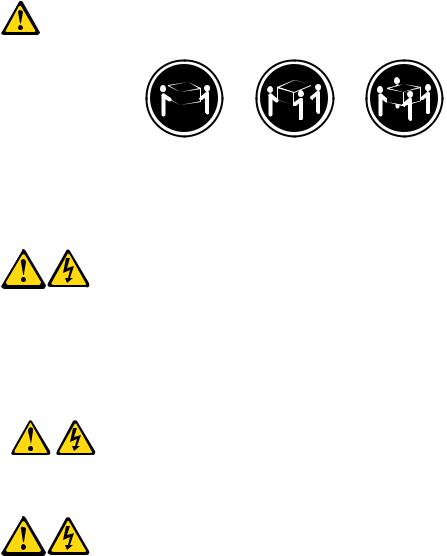
•A utilização de controles ou ajustes ou a execução de procedimentos diferentes dos especificados aqui pode resultar em exposição prejudicial à radiação.
PERIGO
Alguns produtos a laser contêm diodo de laser integrado da Classe 3A ou da Classe 3B. Observe o seguinte:
Radiação a laser quando aberto. Não olhe diretamente para o feixe a olho nu ou com instrumentos ópticos e evite exposição direta ao feixe.
≥18 kg (37 lb) |
≥32 kg (70.5 lb) |
≥55 kg (121.2 lb) |
CUIDADO:
Utilize procedimentos de segurança para levantar equipamentos.
CUIDADO:
O botão de controle de alimentação do dispositivo e o botão para ligar/desligar da fonte de alimentação não desligam a corrente elétrica fornecida ao dispositivo. O dispositivo também pode ter mais de um cabo de alimentação. Para remover toda a corrente elétrica do dispositivo, assegure que todos os cabos de alimentação estejam desconectados da fonte de alimentação.
2 


 1
1 



Chapter 1. Read this first: Important safety information 11
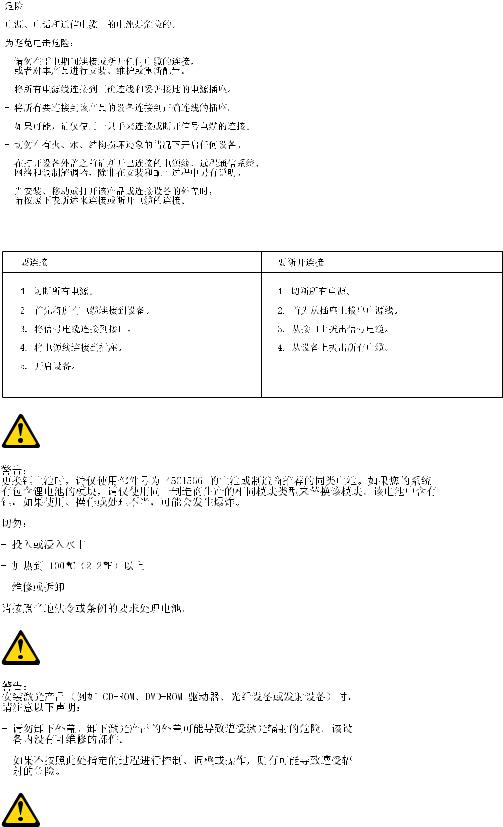
12 ThinkCentre M700, M900 and M900x Hardware Maintenance Manual
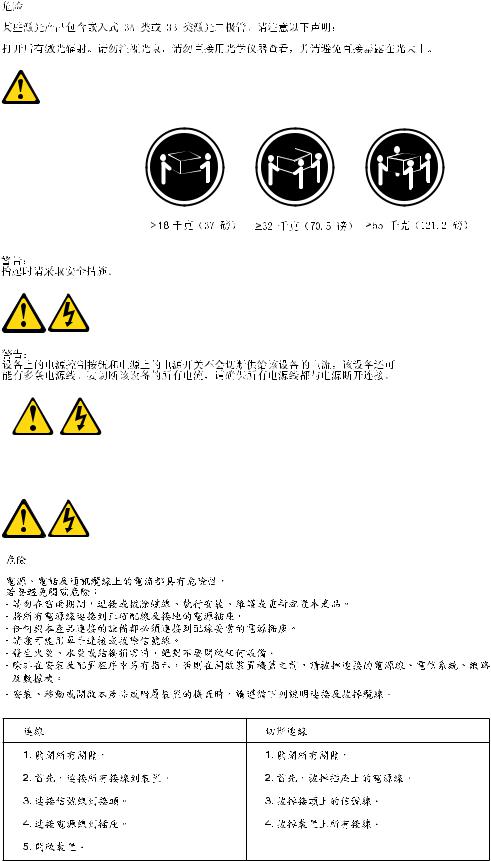
2 


 1
1 



Chapter 1. Read this first: Important safety information 13
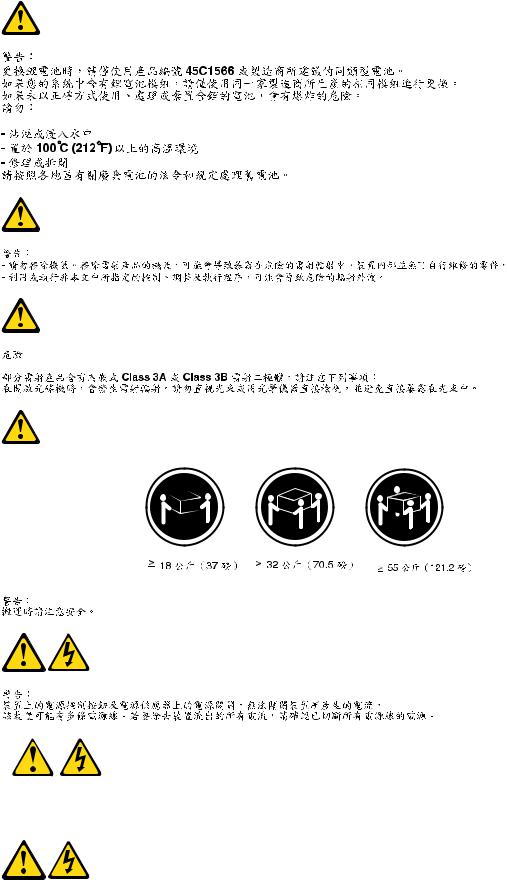
2 


 1
1 



14 ThinkCentre M700, M900 and M900x Hardware Maintenance Manual

DANGER
Le courant électrique provenant de l'alimentation, du téléphone et des câbles de transmission peut présenter un danger.
Pour éviter tout risque de choc électrique :
•Ne manipulez aucun câble et n'effectuez aucune opération d'installation, d'entretien ou de reconfiguration de ce produit au cours d'un orage.
•Branchez tous les cordons d'alimentation sur un socle de prise de courant correctement câblé et mis à la terre.
•Branchez sur des socles de prise de courant correctement câblés tout équipement connecté à ce produit.
•Lorsque cela est possible, n'utilisez qu'une seule main pour connecter ou déconnecter les câbles d'interface.
•Ne mettez jamais un équipement sous tension en cas d'incendie ou d'inondation, ou en présence de dommages matériels.
•Avant de retirer les carters de l'unité, mettez celle-ci hors tension et déconnectez ses cordons d'alimentation, ainsi que les câbles qui la relient aux réseaux, aux systèmes de télécommunication et aux modems (sauf instruction contraire mentionnée dans les procédures d'installation et de configuration).
•Lorsque vous installez, que vous déplacez, ou que vous manipulez le présent produit ou des périphériques qui lui sont raccordés, reportez-vous aux instructions ci-dessous pour connecter et déconnecter les différents cordons.
Connexion |
Déconnexion |
|||
|
|
|
|
|
1. |
Mettez les unités HORS TENSION. |
1. |
Mettez les unités HORS TENSION. |
|
2. |
Commencez par brancher tous les cordons sur les |
2. |
Débranchez les cordons d'alimentation des prises. |
|
|
unités. |
3. |
Débranchez les câbles d'interface des connecteurs. |
|
3. |
Branchez les câbles d'interface sur des connecteurs. |
|||
4. |
Débranchez tous les câbles des unités. |
|||
4. |
Branchez les cordons d'alimentation sur des prises. |
|||
|
|
|||
5. |
Mettez les unités SOUS TENSION. |
|
|
|
|
|
|
|
|
ATTENTION:
Remplacer la pile au lithium usagée par une pile de référence identique exclusivement, (référence 45C1566), ou suivre les instructions du fabricant qui en définit les équivalences. Si votre système est doté d'un module contenant une pile au lithium, vous devez le remplacer uniquement par un module identique, produit par le même fabricant. La pile contient du lithium et peut exploser en cas de mauvaise utilisation, de mauvaise manipulation ou de mise au rebut inappropriée.
Ne pas :
•la jeter à l'eau,
•l'exposer à des températures supérieures à 100°C,
•chercher à la réparer ou à la démonter.
Ne pas mettre la pile à la poubelle. Pour la mise au rebut, se reporter à la réglementation en vigueur.
Chapter 1. Read this first: Important safety information 15
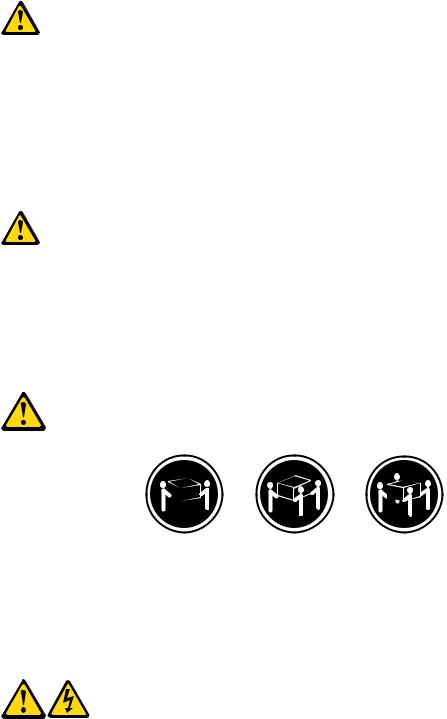
ATTENTION:
Si des produits à laser (tels que des unités de CD-ROM, de DVD-ROM, des unités à fibres optiques, ou des émetteurs) sont installés, prenez connaissance des informations suivantes :
•Ne retirez pas le carter. En ouvrant l'unité de CD-ROM ou de DVD-ROM, vous vous exposez au rayonnement dangereux du laser. Aucune pièce de l'unité n'est réparable.
•Pour éviter tout risque d'exposition au rayon laser, respectez les consignes de réglage et d'utilisation des commandes, ainsi que les procédures décrites dans le présent manuel.
DANGER
Certains produits à laser contiennent une diode à laser intégrée de classe 3A ou 3B. Prenez connaissance des informations suivantes:
Rayonnement laser lorsque le carter est ouvert. Evitez toute expositiondirecte au rayon laser. Evitez de regarder fixement le faisceau ou del'observer à l'aide d'instruments optiques.
≥18 kg (37 lb) |
≥32 kg (70.5 lb) |
≥55 kg (121.2 lb) |
ATTENTION:
Soulevez la machine avec précaution.
ATTENTION:
L'interrupteur de contrôle d'alimentation de l'unité et l'interrupteur dubloc d'alimentation ne coupent pas le courant électrique alimentantl'unité. En outre, le système peut être équipé de plusieurs cordonsd'alimentation. Pour mettre l'unité hors tension, vous devez déconnectertous les cordons de la source d'alimentation.
16 ThinkCentre M700, M900 and M900x Hardware Maintenance Manual

2 


 1
1 



VORSICHT
An Netz-, Telefonund Datenleitungen können gefährliche Spannungen anliegen.
Aus Sicherheitsgründen:
•Bei Gewitter an diesem Gerät keine Kabel anschließen oder lösen. Ferner keine Installations-, Wartungsoder Rekonfigurationsarbeiten durchführen.
•Gerät nur an eine Schutzkontaktsteckdose mit ordnungsgemäß geerdetem Schutzkontakt anschließen.
•Alle angeschlossenen Geräte ebenfalls an Schutzkontaktsteckdosen mit ordnungsgemäß geerdetem Schutzkontakt anschließen.
•Die Signalkabel nach Möglichkeit einhändig anschließen oder lösen, um einen Stromschlag durch Berühren von Oberflächen mit unterschiedlichem elektrischem Potenzial zu vermeiden.
•Geräte niemals einschalten, wenn Hinweise auf Feuer, Wasser oder Gebäudeschäden vorliegen.
•Die Verbindung zu den angeschlossenen Netzkabeln, Telekommunikationssystemen, Netzwerken und Modems ist vor dem Öffnen des Gehäuses zu unterbrechen, sofern in den Installationsund Konfigurationsprozeduren keine anders lautenden Anweisungen enthalten sind.
•Zum Installieren, Transportieren und Öffnen der Abdeckungen des Computers oder der angeschlossenen Einheiten die Kabel gemäß der folgenden Tabelle anschließen und abziehen.
Zum Anschließen der Kabel gehen Sie wie folgt vor |
Zum Abziehen der Kabel gehen Sie wie folgt vor |
|||
|
|
|
|
|
1. |
Schalten Sie alle Einheiten AUS. |
1. |
Schalten Sie alle Einheiten AUS. |
|
2. |
Schließen Sie erst alle Kabel an die Einheiten an. |
2. |
Ziehen Sie zuerst alle Netzkabel aus den |
|
3. |
Schließen Sie die Signalkabel an die Buchsen an. |
|
Netzsteckdosen. |
|
3. |
Ziehen Sie die Signalkabel aus den Buchsen. |
|||
4. |
Schließen Sie die Netzkabel an die Steckdose an. |
|||
4. |
Ziehen Sie alle Kabel von den Einheiten ab. |
|||
5. |
Schalten Sie die Einheit EIN. |
|||
|
|
|||
|
|
|
|
|
CAUTION:
Eine verbrauchte Lithiumbatterie nur durch eine Batterie mit der Teilenummer 45C1566 oder eine gleichwertige, vom Hersteller empfohlene Batterie ersetzen. Enthält das System ein Modul mit einer Lithiumbatterie, dieses nur durch ein Modul desselben Typs und von demselben Hersteller ersetzen. Die Batterie enthält Lithium und kann bei unsachgemäßer Verwendung, Handhabung oder Entsorgung explodieren.
Die Batterie nicht:
• mit Wasser in Berührung bringen.
Chapter 1. Read this first: Important safety information 17
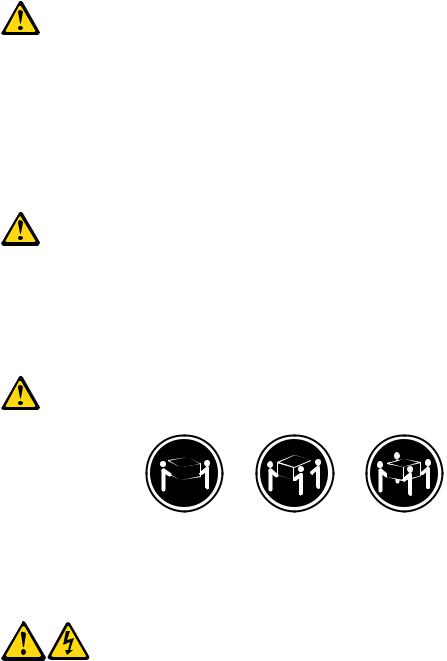
•über 100 C erhitzen.
•reparieren oder zerlegen.
Die örtlichen Bestimmungen für die Entsorgung von Sondermüll beachten.
ACHTUNG:
Bei der Installation von Lasergeräten (wie CD-ROM-Laufwerken, DVDaufwerken, Einheiten mit Lichtwellenleitertechnik oder Sendern) Folgendes beachten:
•Die Abdeckungen nicht entfernen. Durch Entfernen der Abdeckungen des Lasergeräts können gefährliche Laserstrahlungen freigesetzt werden. Das Gerät enthält keine zu wartenden Teile.
•Werden Steuerelemente, Einstellungen oder Durchführungen von Prozeduren anders als hier angegeben verwendet, kann gefährliche Laserstrahlung auftreten.
VORSICHT
Einige Lasergeräte enthalten eine Laserdiode der Klasse 3A oder 3B. Beachten Sie Folgendes:
Laserstrahlung bei geöffneter Verkleidung. Nicht in den Strahl blicken. Keine Lupen oder Spiegel verwenden. Strahlungsbereich meiden.
≥18 kg |
≥32 kg |
≥55 kg |
ACHTUNG:
Arbeitsschutzrichtlinien beim Anheben der Maschine beachten.
ACHTUNG:
Mit dem Netzschalter an der Einheit und am Netzteil wird die Stromversorgung für die Einheit nicht unterbrochen. Die Einheit kann auch mit mehreren Netzkabeln ausgestattet sein. Um die Stromversorgung für die Einheit vollständig zu unterbrechen, müssen alle zum Gerät führenden Netzkabel vom Netz getrennt werden.
18 ThinkCentre M700, M900 and M900x Hardware Maintenance Manual
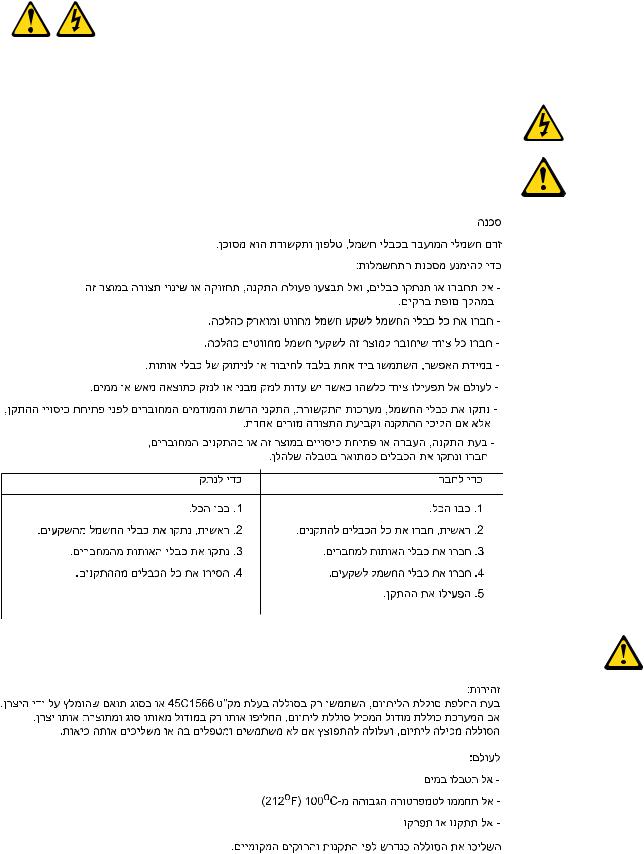
2 


 1
1 



Chapter 1. Read this first: Important safety information 19
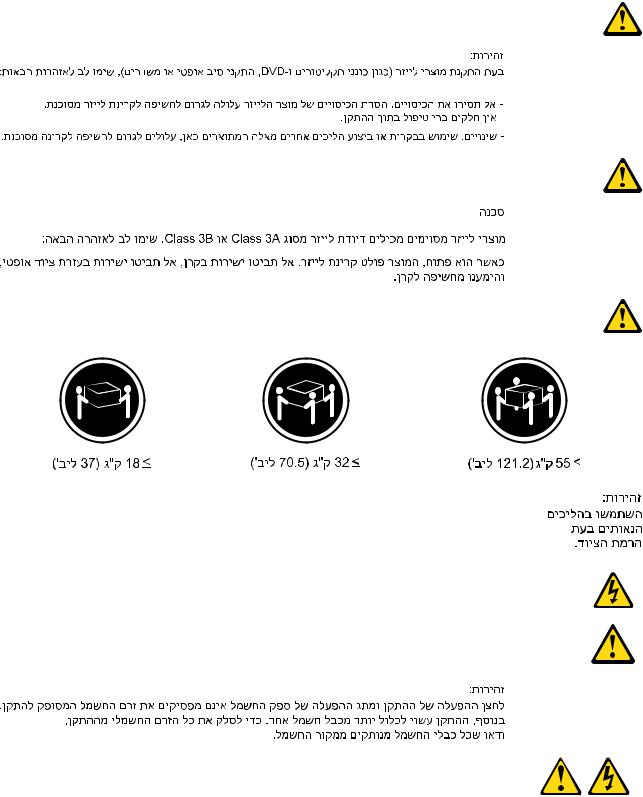
2 


 1
1 



20 ThinkCentre M700, M900 and M900x Hardware Maintenance Manual

PERICOLO
La corrente elettrica proveniente dai cavi di alimentazione, del telefono e di comunicazione può essere pericolosa.
Per evitare il rischio di scosse elettriche:
•Non collegare o scollegare qualsiasi cavo oppure effettuare l'installazione, la manutenzione o la riconfigurazione del prodotto durante un temporale.
•Collegare tutti i fili elettrici a una presa di alimentazione correttamente cablata e dotata di messa a terra.
•Collegare alle prese elettriche appropriate tutte le apparecchiature che verranno utilizzate per questo prodotto.
•Se possibile, utilizzare solo una mano per collegare o scollegare i cavi di segnale.
•Non accendere assolutamente apparecchiature in presenza di incendi, perdite d'acqua o danno strutturale.
•Scollegare i cavi di alimentazione, i sistemi di telecomunicazione, le reti e il modem prima di aprire i coperchi del dispositivo, salvo istruzioni contrarie relative alle procedure di installazione e configurazione.
•Collegare e scollegare i cavi come descritto nella seguente tabella quando vengono effettuate operazioni di installazione, spostamento o apertura dei coperchi di questo prodotto o delle unità collegate.
Per collegarsi |
Per scollegarsi |
|||
|
|
|
|
|
1. |
SPEGNERE le apparecchiature. |
1. |
SPEGNERE le apparecchiature. |
|
2. |
Innanzitutto, collegare tutti i cavi alle unità. |
2. |
Innanzitutto, rimuovere i cavi di alimentazione dalla |
|
3. |
Collegare i cavi di segnale ai connettori. |
|
presa. |
|
3. |
Rimuovere i cavi di segnale dai connettori. |
|||
4. |
Collegare i cavi di alimentazione alla presa. |
|||
4. |
Rimuovere tutti i cavi dalle unità. |
|||
5. |
Accendere l'unità. |
|||
|
|
|||
|
|
|
|
|
ATTENZIONE:
Quando si sostituisce la batteria al litio, utilizzare solo il Numero parte 45C1566 o un tipo di batteria equivalente consigliato dal produttore. Se sul sistema è presente un modulo che contiene una batteria al litio, sostituirlo solo con un tipo di modulo dello stesso tipo della stessa casa di produzione. La batteria contiene litio e può esplodere se usata, maneggiata o smaltita in modo non corretto.
Non:
•Gettare o immergere la batteria nell'acqua
•Riscaldarla ad una temperatura superiore ai 100 gradi C (212 gradi F)
•Smontarla, ricaricarla o tentare di ripararla
Le batterie usate vanno smaltite in accordo alla normativa in vigore (DPR 915/82 e successive disposizioni e disposizioni locali).
Chapter 1. Read this first: Important safety information 21
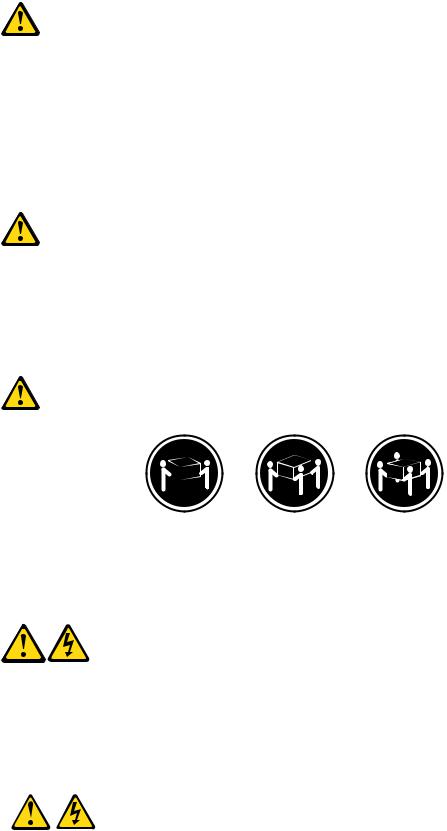
ATTENZIONE:
Quando vengono installati prodotti laser (quali CD-ROM, unità DVD-ROM, unità a fibre ottiche o trasmittenti), tener presente quanto segue:
•Non rimuovere gli sportelli. L'apertura di un'unità laser può determinare l'esposizione a radiazioni laser pericolose. All'interno dell'unità non vi sono parti su cui effettuare l'assistenza tecnica.
•L'utilizzo di controlli, regolazioni o l'esecuzione di procedure non descritti nel presente manuale possono provocare l'esposizione a radiazioni pericolose.
PERICOLO
Alcune unità laser contengono un diodo laser di Classe 3A o Classe 3B. Tener presente quanto segue:
Aprendo l'unità vengono emesse radiazioni laser. Non fissare il fascio, non guardarlo direttamente con strumenti ottici ed evitare l'esposizione al fascio.
≥18 kg |
≥32 kg |
≥55 kg |
ATTENZIONE:
Prestare attenzione nel sollevare l'apparecchiatura.
ATTENZIONE:
Il pulsante di controllo dell'alimentazione presente sull'unità e l'interruttore dell'alimentatore non disattivano l'alimentazione corrente fornita all'unità. E' possibile che l'unità disponga di più cavi di alimentazione. Per disattivare l'alimentazione dall'unità, accertarsi che tutti i cavi di alimentazione siano scollegati dalla fonte di alimentazione.
2 


 1
1 



22 ThinkCentre M700, M900 and M900x Hardware Maintenance Manual
